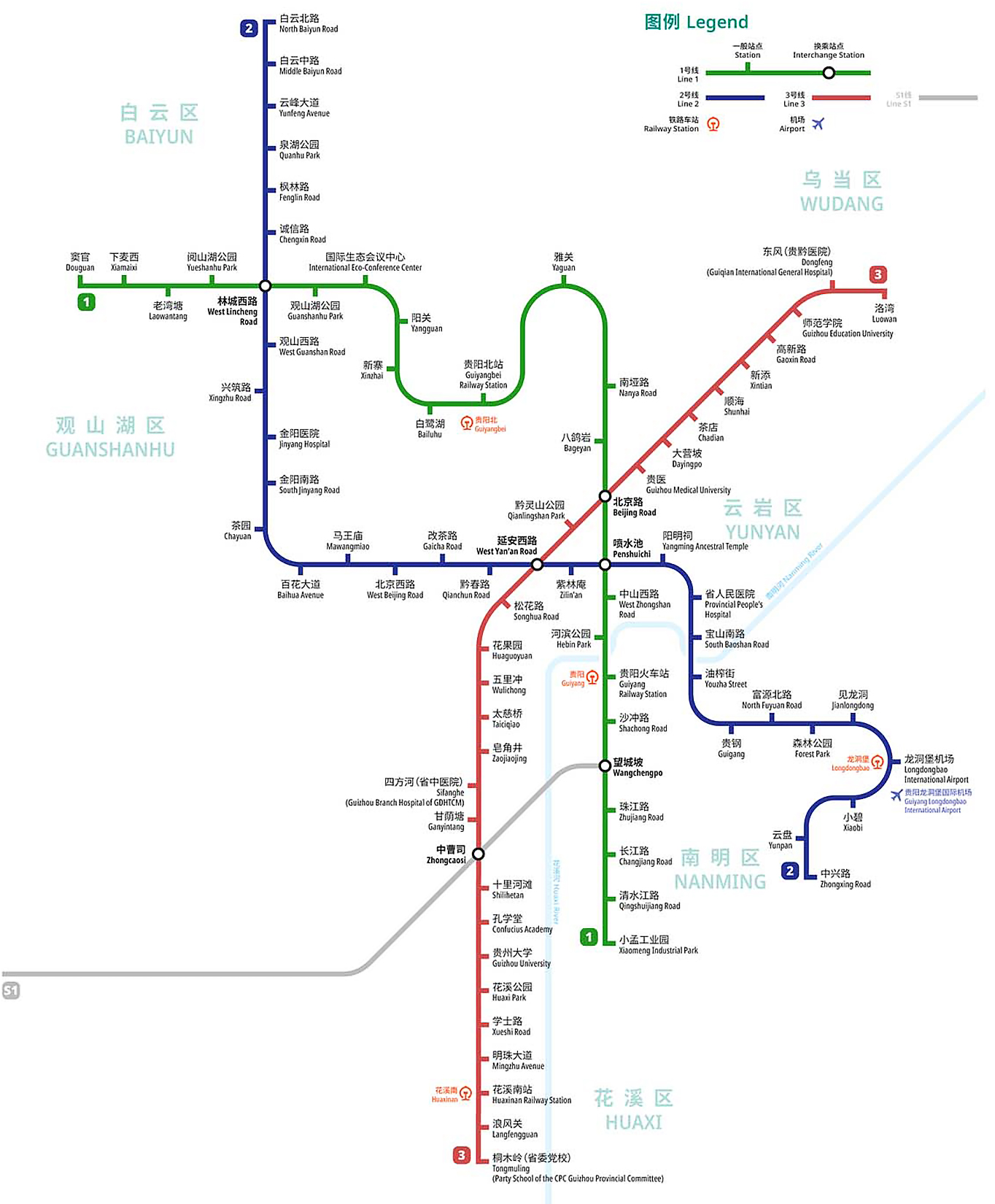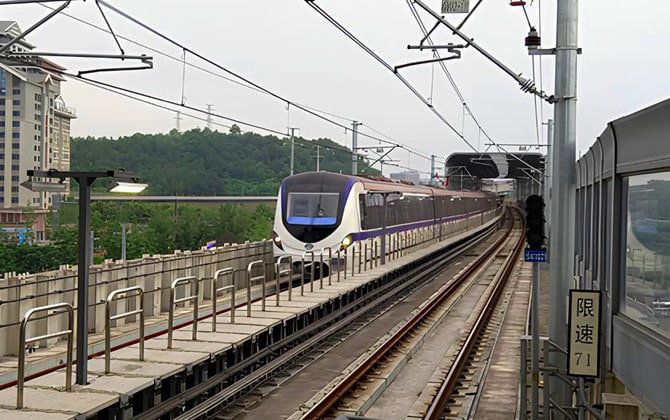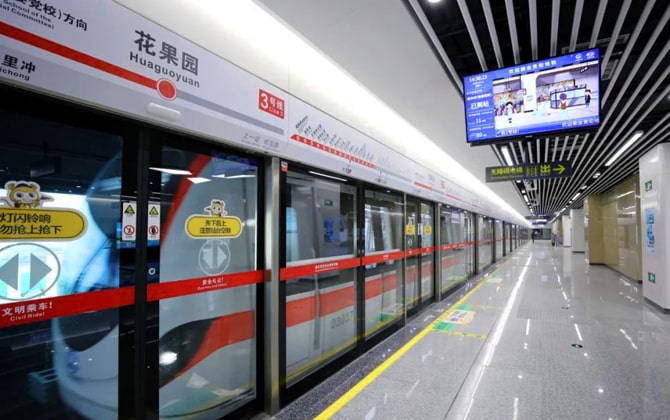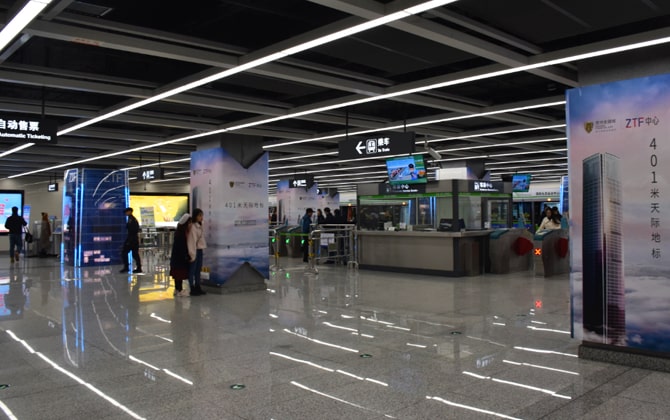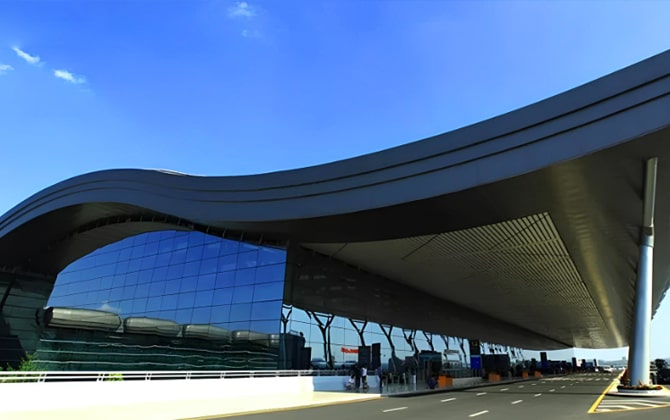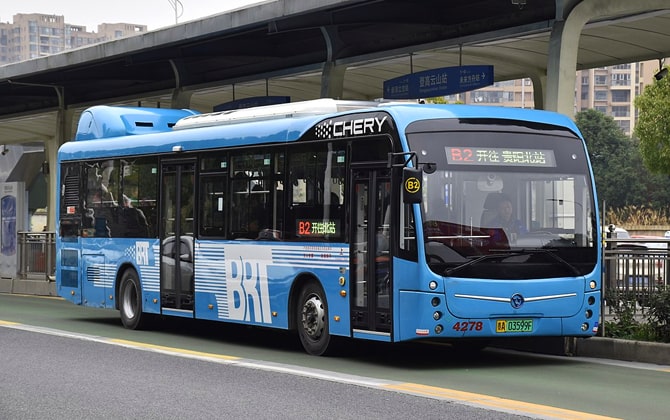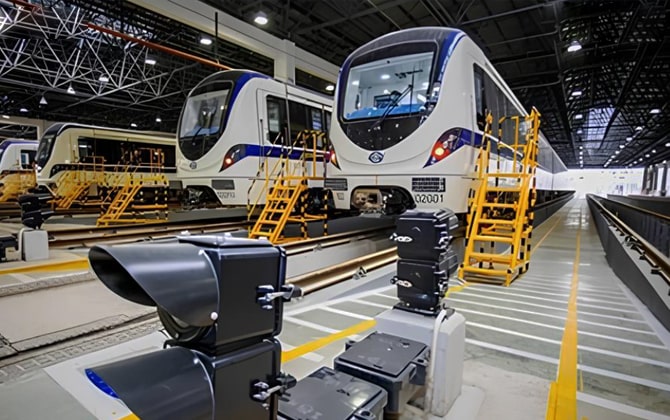The Guiyang Metro is the rapid transit system serving Guiyang, the capital of Guizhou Province in southwest China. It opened in late 2017 and now has four lines as of 2026. The network covers nearly 149 km (92.6 mi) of track and has about 100 stations. It connects urban districts like Yunyan, Nanming, and Guanshanhu with suburban areas. Branded as Guiyang Urban Rail Transit (GYURT), the metro moves hundreds of thousands of passengers each day. Though it is one of China’s newer metro systems, it is modern and efficient. Stations have bilingual signage and English announcements. Trains offer free WiFi and are climate-controlled, with heated seats in winter. The rapid expansion, with four lines opening between 2017 and 2024, shows the city’s commitment to better urban mobility.
Guiyang Metro Map
The 2026 Guiyang Metro map shows all four lines: Line 1, Line 2, Line 3, and Line S1. Each line is color-coded: Line 1 is green, Line 2 is blue, and Line 3 is red. The lines form a grid across the city. Line 1 runs north–south through the city core. Line 2 runs from the northern suburbs, through downtown, to the southeast and reaches the airport. Line 3 arcs from the northeast to the southern districts. Line S1 extends west to the Gui’an New Area. Key interchange stations are clearly marked. Penshuichi links Line 1 and Line 2. Beijing Road links Line 1 and Line 3. West Yan’an Road links Line 2 and Line 3. Wangchengpo links Line S1 with Line 1. Zhongcaosi links Line S1 with Line 3. Riders can find the map at every station and on trains. It is also available in print or PDF form. Station names appear in Chinese characters and Pinyin/English. Major destinations like Guiyang North Railway Station, Guiyang Railway Station, Longdongbao Airport, universities, and parks are easy to locate.
Map of Guiyang Metro showing different lines. Click on the map to enlarge it or download the Guiyang Metro map in PDF format.
Guiyang Metro Lines and Stations
Line 1 (Green)
Line 1 was the first line. It runs northwest to south across the city. The line is 35.1 km (21.8 mi) long and has 25 stations. It opened in late 2017 and was completed by 2018. The north end is Douguan in Guanshanhu District. The south end is Xiaomeng Industrial Park in Huaxi District. Key stops include Guiyang North Railway Station, Penshuichi (downtown shopping and interchange with Line 2), Beijing Road (interchange with Line 3), and Guiyang Railway Station. Line 1 links dense urban areas with suburbs and crosses the Nanming River twice. It provides access to Qianling Park via Beijing Road Station and to the Hebin Park area. A trip from end to end takes about one hour. Trains use 1500 V DC overhead power and have full platform screen doors for safety.
Line 2 (Blue)
Line 2 opened in April 2021. It runs from the northern suburbs to southeast Guiyang. The line is 40.6 km (25.2 mi) long with 32 stations. Thirty stations are underground and two are elevated. It starts at North Baiyun Road in Baiyun District and ends at Zhongxing Road in Nanming District. Line 2 cuts through the city center. It intersects Line 1 at West Lincheng Road and at Penshuichi. It intersects Line 3 at West Yan’an Road. It also serves Longdongbao International Airport near its southeast end. Travelers can go from Guiyang North Railway Station through downtown to the airport on one line. Major stops include Provincial People’s Hospital, Youzha Street, and Forest Park, serving central commercial areas and a large green space. Line 2 cuts crosstown travel times. A ride from downtown (Penshuichi) to the airport takes about 30 minutes by metro. Stations have bilingual signage and announcements. Most have multiple exits to connect with city bus routes.
Line 3 (Red)
Line 3 is the newest heavy metro line. It opened in December 2023. The line is 43.0 km (26.7 mi) long with 29 stations. All stations are underground. It starts at Luowan in Wudang District and ends at Tongmuling in Huaxi District. Line 3 serves educational and residential zones, stopping at Guizhou University and nearby campuses via Huaxi Park and College of Agriculture stations. In the city center, it passes near Qianlingshan Park at Qianlingshan Park Station. It intersects Line 1 at Beijing Road and Line 2 at West Yan’an Road. It also links with Line S1 at Zhongcaosi station. Notable stops include Huaguoyuan and Sifanghe Road. Line 3 improves north–south connectivity, offering a one-train ride from northeast suburbs to Huaxi university town and southern Guiyang. All stations have elevators and barrier-free access. Trains run at a design speed of 80 km/h (49.7 mph), carrying up to about 2,000 passengers when full.
Line S1 (Suburban Line S1)
Line S1 opened in December 2024 as Guiyang’s first suburban metro line. The line is 30.3 km (18.8 mi) long with 13 stations. About two-thirds of it is underground and one-third is elevated. It connects Guiyang city proper with the Gui’an New District west of the city. The western terminus is Zaojiaoba in Qingzhen/Gui’an New District. From there, Line S1 runs east through Huaxi District and ends at Wangchengpo in Nanming District. At Wangchengpo, riders can transfer to Line 1, linking the new suburb to the main network. The route includes Tianhetan station, a scenic area southwest of the city, and passes through emerging tech zones—Shugu Avenue station serves a digital industry park. It also intersects Line 3 at Zhongcaosi station. Because it extends beyond Guiyang into Gui’an, the line is built for higher speeds and uses a mix of tunnels and elevated viaducts. You can notice above-ground stations toward the Gui’an end. Line S1 has spurred development in the Gui’an New Area. The “S” stands for “suburban,” highlighting its role in connecting satellite cities. Trains and stations on S1 have the same amenities as main lines. City transit cards and tickets work with the same fare rules.
Each station has real-time electronic displays, restrooms, escalators, and accessibility features. Many stations reflect local culture; for example, some feature Guizhou’s ethnic minority art. Safety is a priority. Stations have platform screen doors and are monitored by staff and cameras. The cleanliness and efficiency often impress first-time visitors.
Guiyang Metro Schedule & Timetable
Operating Hours Today
Guiyang Metro runs daily from roughly 6:30 AM to 11:00 PM. First trains leave terminus stations around 6:30–7:00 AM, depending on the line. Last trains depart around 10:30 PM and finish service by about 11:00 PM. Exact times vary by station. For example, at Guiyang North Railway Station (Line 1), the first outbound train was 7:30 AM and the last inbound train arrived around 11:20 PM. Station entrances close a few minutes before the final train. In the early morning, gates open just before the first train. There is no 24-hour service—maintenance runs after midnight. Holiday schedules usually match weekdays, but on major holidays, service may extend later. Late-night travelers after 11:00 PM must use taxis or other options.
Opening and Closing Times
Below are approximate first and last train times for each line as of 2026. Always check the posted Guiyang Metro schedule at your station for exact times.
- Line 1 (Green): First trains depart ends at 6:30–6:45 AM. Last departures around 10:30 PM, with final arrivals by 11:00 PM. At North Railway Station, the first inbound train may not arrive until about 7:00 AM. By 11:30 PM, all stations close.
- Line 2 (Blue): First trains around 6:30–6:45 AM. Last trains leave ends around 10:20–10:30 PM, finishing by 11:00 PM. Airport station service starts around 7:00 AM and ends by 11:00 PM.
- Line 3 (Red): First departures roughly 6:30–7:00 AM. Last departures around 10:15–10:20 PM, with service ending near 11:00 PM.
- Line S1 (Suburban): First trains around 7:00 AM. Last departures around 10:00–10:30 PM, finishing routes by about 10:50 PM.
Each station displays a timetable of first and last trains. If you miss the last train, station staff will guide you to exit since no more trains run.
Frequency & Train Schedule
Train intervals vary by time of day. During morning and evening rush (around 8:00 AM and 6:00 PM), expect trains every 5–6 minutes on major lines. In normal daytime, intervals are 7–8 minutes. Off-peak (late evening, early afternoon) gaps may reach 10–12 minutes. Even at quieter times, you rarely wait more than 10 minutes.
End-to-end travel times (with distances in km and miles):
- Line 1: 35 km (21.7 mi) end-to-end in about 55 minutes.
- Line 2: 40 km (24.9 mi) end-to-end in about 60 minutes.
- Line 3: 43 km (26.7 mi) end-to-end in about 65 minutes.
- Line S1: 30 km (18.6 mi) end-to-end in about 40–45 minutes.
Most station-to-station hops take 2–3 minutes. In suburban stretches, hops may take 3–4 minutes. For example, North Railway Station to Penshuichi (8 stops on Line 1) takes about 15–18 minutes.
Each train has six cars. A normal load holds about 1,460 passengers seated and standing. At crush load, each train can carry up to about 2,062 passengers. During peak hours, trains can be crowded but remain orderly. Overhead hand straps and rails are available for standing passengers.
Stations have electronic boards that display the next few train times. The Guiyang Metro app and WeChat mini-program show live timetables and crowding levels. In most cases, precise planning is unnecessary. Simply go to the platform and wait for the next train. Overhead displays also indicate if a train is the “last train of the day” for that direction.
Pro Tip: If you miss a train and the platform is crowded, wait near the marked door positions on the platform floor. Middle cars often have more space at peak times, as passengers tend to cluster near exits. Always check overhead displays for last-train warnings to avoid getting stranded.
Guiyang Metro Ticket Prices & Fares
Fare Calculator
Guiyang Metro uses a distance-based fare system. Fares are low and increase gradually with distance. Below is the fare structure (prices in CNY and USD; distances in km and mi):
| Distance Traveled | Fare (CNY) | Approx. Fare (USD) |
|---|---|---|
| 0 – 4 km (0 – 2.5 mi) | ¥2 | ~$0.30 |
| 4 – 8 km (2.5 – 5 mi) | ¥3 | ~$0.45 |
| 8 – 12 km (5 – 7 mi) | ¥4 | ~$0.60 |
| 12 – 18 km (7 – 11 mi) | ¥5 | ~$0.75 |
| 18 – 24 km (11 – 15 mi) | ¥6 | ~$0.90 |
| Beyond 24 km (beyond 15 mi) | +¥1 per 8 km | +~$0.15 per 5 mi |
The base fare for a short trip (up to 4 km / 2.5 mi) is ¥2 (~$0.30). Each additional 4 km (2.5 mi) segment adds ¥1 until 18 km (11 mi). Beyond 18 km, each 8 km (5 mi) adds ¥1. Most cross‐city trips cost no more than ¥6–7 (≈$0.90–$1.05). The longest ride (around 50 km / 31 mi) costs about ¥7–8 (≈$1.15). You don’t need to calculate fares—the system computes them on exit.
Children: Under 1.3 m (4′3″) ride free. Taller children (under age limit) pay half fare.
Seniors: Residents over 70 ride free with a senior transit card or ID. Visitors over 70 may inquire at service counters for free rides.
Disabled & Others: Passengers with appropriate permits (e.g., veterans, disabled) ride free or at reduced cost.
There are no peak/off‐peak surcharges. Fares are distance‐based all day. Transfers within the metro count as one trip; exiting and re‐entering starts a new fare.
Ticket Types and Day Pass
Guiyang Metro offers several ticket options:
- Single‐Ride Ticket (Token): Buy at vending machines with cash or bank card. Choose destination; machine issues a green token. Tap at entry and insert at exit. Valid only on day of purchase and for that station pair.
- Guiyang Transportation Smart Card (Yang Cheng Tong): A contactless IC card for frequent users. Tap to enter and exit; earns 10% discount (e.g., ¥5 fare becomes ¥4.50). Purchase at station service desks with a refundable ¥20 (~$3) deposit plus initial balance. Top-up at machines or counters by cash or mobile pay. The same card works on buses and some taxis.
- Mobile Payment (QR Code): Use WeChat, Alipay, or the official Guiyang Metro app to generate a QR code. Scan at gates to enter and exit. Pays full fare (no discount unless linked to a transit card). No token or card needed.
- Paper Tickets / IC Cards: Most stations still use tokens. Some newer stations may issue thin IC cards instead of tokens.
- Day Pass / Multi‐Day Pass: Guiyang Metro does not offer unlimited day or multi‐day passes as of 2026. Even with six rides, you’d spend about ¥20 (~$3), so no pass is needed.
- Other Concessions: Students and other groups can get discounted stored‐value cards with ID.
How to buy & use the smart card
To get a smart card, go to any station’s customer service desk (“Customer Service” booth). Ask for “办卡 (ban ka)” to request a card. Pay a ¥20 (~$3) deposit, then load funds. To ride, tap the card reader on the turnstile when entering and exiting. The fare and 10% discount apply automatically. The exit gate shows the remaining balance. To top up, place the card on a vending machine sensor, select “Recharge,” and add cash or scan a payment code.
If you’re visiting briefly, return the card at any station service counter before you leave. They will refund the remaining balance and deposit in cash. If you keep the card, it can be used for future visits.
How Much Does Guiyang Metro Cost?
Guiyang Metro is very affordable for both locals and travelers. Typical fares:
- Short trip (under 4 km / 2.5 mi): ¥2 (~$0.30). For example, Penshuichi to Guiyang Railway Station.
- Airport trip (≈11 km / 6.8 mi): ¥5 (~$0.75). This is much cheaper than a taxi (¥50+) or airport bus (¥20).
- Longest ride (≈50 km / 31 mi): ¥7–8 (~$1.00–$1.15). Example: Xiaomeng Industrial Park to North Baiyun Road with a transfer.
- Guiyang North Station to Gui’an New District (≈30 km / 18.6 mi): ¥6–7 (~$0.90–$1.05).
Most one‐way trips cost ¥2–6 (~$0.30–$0.90). A commuter who spends ¥4 each way pays ¥8 (~$1.15) per day. With a smart card (10% discount), the daily cost is about ¥7.20 (~$1.05). There are no hidden fees or peak surcharges.
Transfers between lines are free as long as you stay inside the system. Exiting and re‐entering counts as a new trip.
If you also ride city buses, use the same smart card. Bus fares are ¥1 or ¥2 (~$0.15–$0.30), often with a small discount for card users. With metro and bus rides combined, most sightseeing days cost under ¥10–15 (~$1.50–$2.50).
Routes and Connections
Connections with Guiyang Bus and Airport
Guiyang Metro integrates with buses, trains, and the airport. Metro Line 2 serves Guiyang Longdongbao International Airport (KWE). Longdongbao International Airport Station is at Terminal 2. From the plane, grab your luggage and head to the station. From downtown, the ride takes about 20–30 minutes with a fare of ¥5 (~$0.75). This station shares platforms with Longdongbao Railway Station (high-speed rail) and the Airport Bus Terminal. Here, high-speed rail, metro, bus, and air travel all converge.
Line 2 links the airport with Guiyang North Railway Station and Guiyang Railway Station. You can take a high-speed train to North Station, then board Line 2 to the airport or downtown in one trip.
Many metro stations connect to city buses. Guiyang North Railway Station (Line 1 terminus) is a hub for 24 bus routes, including an airport shuttle. Outside North Station, a large bus station serves city lines, taxis, and parking. Jinyang Bus Station is near Line 2. Hebin Park (Line 1) has bus links to other areas.
Buses stop right outside station exits or within a short walk. At some stations, an underground passage leads to a bus terminal. Use the Guiyang Transportation Smart Card for both bus and metro rides. There is no time-based transfer discount, but one card works for all rides.
The metro covers main north–south and east–west corridors. Buses serve areas far from metro stations. For example, you could ride the metro to Hebin Park, then catch Bus No. 26 to Huaxi, near Line 3. Before Line 3 opened, Bus 26 was essential. Now, you can use the metro for most of the journey and the bus for the final leg.
Stations display signs for nearby bus routes. Exit signage shows bus numbers. If unsure, ask station staff or look for the “公交 (bus)” symbol.
Guiyang does not have a full BRT system, but major roads have dedicated bus lanes. Regular buses feed into metro stations. Future tram Line T2 will add more connections.
Before the metro link, airport shuttle buses ran from downtown. These still operate, but most travelers prefer the metro for reliability. The airport bus station is one stop from Line 2 station. If you travel before 6:30 AM or after 11:00 PM (when the metro is closed), use shuttle buses or taxis.
Transfers between metro and other transport are easy. If you arrive at Guiyang East Railway Station, take a bus or taxi for about 15 km (9.3 mi) to the nearest metro station. Guiyang East isn’t on the metro yet (Line S2 will connect in the future). At Guiyang North Station, go to level B2 to board Line 1. At the airport, follow “Metro” signs in the terminal to reach Line 2. To visit Qingyan Ancient Town outside the city, take Line 3 to Huaxi, then catch a bus or taxi.
Facilities & Services
Parking Charges per Day
Guiyang Metro offers park-and-ride at some suburban and interchange stations. Downtown stations rarely have parking due to space limits. For example, Guiyang North Railway Station (Line 1) has an underground garage. Rates there are ¥3 per hour (7:00–22:00; ≈ $0.45/hour) and ¥4 flat overnight (≈ $0.60). A full 24-hour stay costs about ¥49 (≈ $7). If you park two hours, expect to pay ¥6 (≈ $0.90).
Guiyang East Railway Station (not yet on the metro) charges about ¥1.5 per half hour (≈ $0.20/30 min). Metro-only station lots follow city standards, often around ¥1–2 per 30 minutes (≈ $0.15–$0.30). There is no combined parking-and-metro ticket—pay parking separately to the lot operator and metro fare at the gates.
Some garages offer monthly passes (e.g., ¥200/month, ≈ $30). Parking can fill up on weekdays at busy stations like North Railway. If full, consider parking farther out and riding one metro stop.
If you want to park at the airport and ride the metro, note that airport parking costs about ¥97 for 24 hours (≈ $15), which is higher than station parking. Most riders park at a metro station, not the airport.
Many stations provide bicycle racks or docks near entrances. These are usually free but unguarded. E-bike riders often park outside stations; dedicated e-bike parking or charging zones may exist at some suburban stations but are not unified.
Overall, daily parking costs for metro users range from about ¥20–50 (≈ $3–$7), depending on location and duration. Short stays (a few hours) cost only a few yuan. Many lots offer a 15–30 minute grace period—check posted signs. Avoid illegal curbside parking; fines or towing may apply. Always use designated lots.
Guiyang Metro Card – How to Use
The Guiyang Metro smart card is a stored-value transit card. You can use it for metro rides, city buses, and some other services. Follow these steps to get and use the card:
- Obtain the Card: Go to any station’s Customer Service Center. Ask for “办交通卡” (ban jiāotōng kǎ). Pay a refundable ¥20 deposit (≈ $3). Add an initial balance—¥10–20 (≈ $1.50–$3) is enough to start. You receive a receipt and the card within minutes.
- Reload: Use ticket machines in stations. Switch to English if needed. Select “Recharge,” place your card on the reader, then insert cash (¥5, ¥10, ¥20, ¥50) or use mobile payment. Machines do not give change, so insert the exact amount. You can also reload at service counters with cash or mobile pay.
- Enter & Exit: Tap the card on the reader pad (yellow or green) at the fare gate. The gate beeps and opens. At your destination, tap again. The fare, minus a 10% discount, is deducted immediately. The exit gate display shows the deduction and remaining balance. Always tap out to avoid being charged the maximum fare.
- Card Benefits: You receive a 10% discount on metro fares. For example, a ¥5 trip costs only ¥4.50 (≈ $0.68). On buses, the card often deducts ¥0.90 for a ¥1 fare. Using the card saves time—no need to buy tokens each ride.
- Use Elsewhere: The card is part of China T-Union. If you see the T-Union logo in another city’s metro or bus, your Guiyang card may work there. You cannot reload it outside Guiyang, so plan accordingly. It also works on some shared taxis or bike rentals, though primary use is bus and metro.
- Check Balance: When you exit, the gate shows your remaining balance. To check later, tap the card on a ticket machine in “Card Balance” mode. Some new machines display your balance when you place the card on the reader. Station staff can also check it.
- Maintain Balance: Keep at least ¥10 (≈ $1.50) on the card. If the balance falls below ¥2, you cannot enter.
- Lost Card: Cards are anonymous. If you lose it, the balance and deposit are gone. Treat it like cash. If you find a lost card in a station, staff may help, but chances are slim.
- Return Card: To get your deposit and unused balance back, go to a main station service desk. Say “退卡” (tuì kā). If the card is undamaged and over 24 hours old, you receive the full ¥20 deposit and any balance in cash. Some stations charge a small fee if the card is damaged.
- Mobile Option: You can use QR codes via WeChat, Alipay, or the official Guiyang Metro app instead of a card. However, a physical card works without a phone or data, which is helpful if your battery dies.
- Paper QR Ticket: If machines fail, staff may sell a paper QR ticket for a single trip. These are temporary—steady riders benefit more from the smart card.
- Other Uses: In Guiyang, the card is mainly for metro and bus. Some intercity rail or public shuttles accept it if integrated. Rarely, it can be used for small purchases at select locations.
Future Expansions & Upcoming Lines
Line T2 (Tram Line 2)
Line T2 is Guiyang’s first modern tram. Construction is underway as of 2026. It will run 10.9 km (6.8 mi) with 13 stations. The tram will serve the city center, filling gaps left by heavy metro lines. It may run on street level or in dedicated lanes with frequent stops. The first phase is expected in 2026. International Eco-Conference Center station (Line 1) was built for a future interchange with T2. T2 will connect Guanshanhu District and the conference center. When open, the tram will handle local trips along its corridor. Tram fares will likely use the metro’s ticketing system.
Line 4
Line 4 is a planned east–west metro line in southern Guiyang. It is in advanced planning as of 2026. The line will run about 35–40 km (22–25 mi) from Jinzhai Road to Xiaguzhong. It will serve southeast districts that currently rely on road transport. Construction had not started by 2026. Line 4 may open in the late 2020s.
Line S2
Line S2 will link Guiyang East Railway Station with northern suburbs. It will bring metro service to Guiyang East, which is not yet on the network. Once built, all three major rail stations (North, East, Guiyang) will have metro access. As of 2026, S2 is in planning.
Line S3 and S4
Line S3 is planned from Liguan to Heshangtu, serving northeast districts. Line S4 is planned from Yuliangqiao to Machanghe, serving southwest corridors. These suburban lines will likely have longer station spacing and higher speeds. They will connect outer towns or counties to the city core. S3 and S4 are in planning as of 2026.
Line G1
Line G1 will run through Gui’an New Area (G for Gui’an). The proposed route is Longjingcun to Free Trade Zone. It will link Gui’an more extensively to Guiyang’s metro network. Gui’an is a national development zone with government and tech offices moving there. Line S1 already touches Gui’an; G1 will cross it. In the future, G1 could extend toward Anshun. As of 2026, G1 is in planning.
Expansion of Existing Lines
Plans exist to extend current lines. Line 1 could extend at both ends. Line 2 may reach further north or southeast. Line 3 might extend into northwest Wudang. As of 2026, immediate focus remains on new lines rather than extensions.
Network Scale Goal
Guiyang’s long-range plan calls for nine lines totaling about 467 km (290 mi). This is a large expansion from the current 149 km (93 mi). The target completion is around 2035–2040. If built, Guiyang’s metro will rival cities like Nanjing or Wuhan in length. The expansion is driven by rapid urban growth and Gui’an’s integration into the region.
Timeline & Construction
As of 2026, Line T2 is under construction and due in 2026. Line S2 may break ground soon, though this is unconfirmed. Lines 4, S2, S3, S4, and G1 are in planning and not yet under construction. Chinese metro projects often fund multiple lines at once. In the next few years, two or three lines may enter construction simultaneously.
Integration with Region
Guiyang plans to integrate its metro with regional rail, such as Guiyang–Kaiyang commuter lines. The Guiyang Loop Line and Guiyang–Kaiyang are suburban commuter rails using similar electric trains. Line G1 may tie into these lines or coordinate with them. The goal is a unified transit network for Greater Guiyang.
Future Airport Line?
Currently, Line 2 serves the airport. If Guiyang builds a new terminal or expands the airport area, a dedicated airport express or new spur may be considered. As of 2026, no such plan exists, since the current connection on Line 2 meets demand.
Technology Upgrades
Future lines may debut driverless trains. Many Chinese cities now use full automation on new lines. Guiyang’s current lines have drivers. Lines S2 or S3 could employ CBTC signaling for higher frequencies and feature platform screen doors for safety. These upgrades will improve capacity and reliability.
Interchanges
New interchange stations will appear as lines cross. For example, Line 4 may intersect Line 1 and Line 3 in Huaxi or Nanming districts. Some existing stations have reserved space for future transfer passages. As the network grows, transfers will become more convenient.
Ridership and Impact
After Lines 4 and S2 open, daily ridership could exceed 1 million. Expanded metro service will alleviate road congestion, especially in Guiyang’s valley roads that often bottleneck. More lines will offer reliable, fast alternatives to driving, reducing travel times across the city and suburbs.
